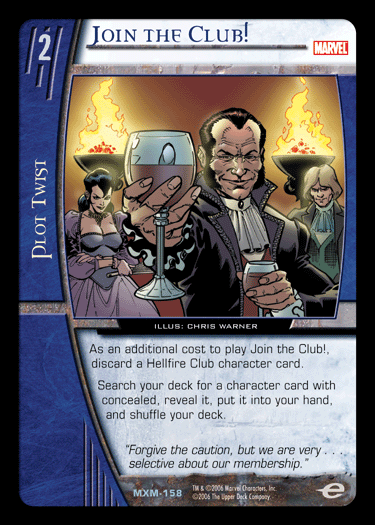
Being new to the Vs. System development team has been quite interesting. I’m having so much fun learning about all the things I took for granted when I played the game we all love. When I first moved to California to work for UDE, I had an idea of what my strengths and weaknesses were, and I also had an idea of what I wanted to add to the already great development team.
When designing a card, there are many factors to take into account. How interesting is this card? How fun, flavorful, and thematic will this be? Is it open-ended? My favorite types of cards are the ones that answer “yes” to the third question.
When I started playing, Signal Flare was the first search card to catch my eye. It has been a staple in our game for the last year and a half. Character search cards set a benchmark that players look for before deciding if they want to play a specific team. Signal Flare is a very powerful card, so you see it in most Fantastic Four decks. But how open-ended is it? What happens if you are not teamed-up with Doom and you really need to look for Dr. Doom, Diabolic Genius? Nothing happens. You are forced to look for Invisible Woman, Sue Storm and not make your optimal drop on turn 4. So, while Signal Flare is very powerful, it’s not very open-ended.
Then you have a card like Hero’s Welcome, which gives deckbuilders and players a little more liberty. Yes, you have to play JLA, but you can discard any two cards. You can play a two-team JLA deck and run Hero’s Welcome to make sure you hit your curve. The only deck constraint is that you must have a JLA character at each drop point. Not teamed-up with the Brotherhood? That’s okay—you can still discard that Toad, Mortimer Toynbee that you bounced on your third turn to go search for your later drops.
The next search card that illustrates open-endedness is Enemy of My Enemy. It gives deckbuilders an array of choices. You can play two teams that don’t have a character search card. You can play one team and cherry pick the best drops from various teams. You can easily play an honest three-team deck. The only restriction is that you can’t discard character cards that have the same printed affiliation as the character you want to get.
This takes me to my card.

Join the Club! is very open-ended. It allows you to discard a Hellfire Club character to find any concealed character. You can go get a Marvel Knights guy, a Crime Lords character, or an Anti-Matter character. The options are endless. You don’t have to be teamed-up. Unlike with Enemy of My Enemy, you can go get a Hellfire Club character after the discard. My favorite thing about this card is its threshold cost of 2. Search cards that cost 2 are hard to come by. Having a 2-drop when your opponent misses on his or her second turn is quite an advantage.
Join the Club! is a great thematic card for the Hellfire Club. It’s flavorful and fun. It’s also very interesting because it looks for a specific type of character. Most of all, it’s very open-ended. You can do so much with Join the Club!. If you had asked me a few months back if I’d ever want to make a card that gives players hundreds of combinations in their deckbuilding choices, I would have told you, “No way!” But I am a changed man. Keeping cards open-ended is a great way to keep our game exciting, fun, and fresh!
Until next time, have fun searching for Hounds of Ahab, Kiman, or even Grandmaster.
Cheers,
Antonino De Rosa